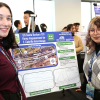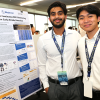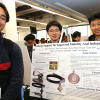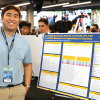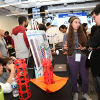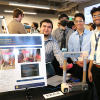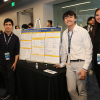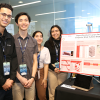Seventeen Senior Design Projects Win Dean’s Choice Awards
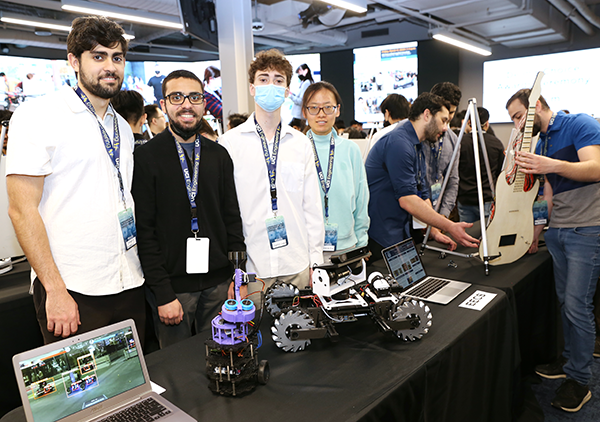
April 4, 2023 - The Samueli School of Engineering 2023 Annual Design Review was held from 1 to 4 p.m. on March 17, St. Patrick’s Day, at Beall Applied Innovation’s the Cove. A new location for the event, the Cove offered free parking for visitors and enough space to host all 188 senior design project teams.
More than 900 attended the event, in which students from all six engineering departments shared their projects. The senior design program provides students with hands-on learning experience and professional development through innovative projects that bridge academic fundamentals with real-world challenges. After working in teams on their projects for two quarters, students are then able to present their ideas by displaying or demonstrating them to a wider audience at Design Review.
Associate Dean for Undergraduate Affairs Mike Green welcomed the students, staff, faculty, alumni and industry reviewers to the event. Green, in consultation with Dean Magnus Egerstedt, selected 17 projects for Dean’s Choice Awards. Here are the winners from each department.
Biomedical Engineering
Waking Dead in Bed
The purpose of this project is to wake people with type 1 diabetes from their sleep before entering a hypoglycemic state that has the potential to cause coma and even death. This device would alternate through various auditory alarms, as well as an olfactory alarm, to avoid causing alarm fatigue within patients, which can lead to the lack of emergency glucagon administration that prevents death.
Team members: Adam Peters, Angelica Esteves, Siana Jimenez, Leslie Rangel, Rebeca Silva
Patient Tracking and Following IV Pole
This team is creating a new IV pole device that will track ambulatory pediatric patients, following them and allowing patients, nurses and parents to intervene less. The goal is to empower these patients with a stronger sense of normalcy, mobility and freedom in their lives.
Team members: Ulysses Castillo, Leilany Lim, Isela Magallon, Amal Tabban, Katie Trimble
Wearable LLLT Device for Burn Wound Therapy
This project is an innovative low-level light therapy (LLLT) wearable device that aims to boost cellular regeneration and expedite recovery times for burn patients. The disposable, wearable design targets the at-home user and burn care centers, providing an effective, affordable product, unlike existing LLLT devices.
Team members: Dustin Luong, Renzo Calilung, Fretherich Pinardo, Temi Jekayinfa
Chemical and Biomolecular Engineering
Controlling an Infinity Fountain Infinitely
This experiment looked at the effectiveness of different process controllers (PID) on maintaining the liquid level of a tank that undergoes disturbances. Properties of proportional (P), derivative (D), integral (I) and combinations of these controllers were investigated when exposed to a set point change. Furthermore, the impact of tuning on the PID controller was studied by using the Ziegler-Nichols optimization technique. The team concluded a tuned PID controller is an ideal process controller and should be implemented to maintain process operating conditions. They put their theory to practice on the UCI Infinity Fountain.
Team members: Sama Hamouda, Katia Salcedo, Derek Lam, Kevin Nguyen
Effects of Temperature on the Reaction Kinetics of the Saponification of Ethyl Acetate
Chemical reactors can be categorized in several ways, each type having unique advantages: batch, semi-batch or continuous flow; steady-state or dynamic; plug-flow or well-mixed. For the purposes of understanding the kinetic effects of a reaction of interest (saponification of ethyl acetate with sodium hydroxide), the team used a continuous stirred-tank reactor (CSTR), which allows reactants to be effectively mixed and converted to products while also allowing continuous flow of new reactants through the system. These CSTRs are an ideal choice for liquid-phase reactions as mixing permits higher reactor volume utilization and more efficient heat transfer, critical for maintaining a safer reactor temperature. The effects of reactor temperature on the saponification reaction of ethyl acetate was controlled and measured while keeping all other variables constant. While current research is often done using a conductometric technique, the team used a classical titration method to analyze the conversion of the resulting product from the hydrolysis of ethyl acetate. After confirming the reaction kinetics increased with temperature, they extended their results to determine the feasibility of using this chemistry as a feedstock for biofuel production.
Team members: William Galloway, Filip Mackowicz, Chad Hemmig, Patrick Yang
Civil and Environmental Engineering
Materials Matter: Lower Embodied Carbon at the Beginning of a Carbon Lifespan
This project involves compiling and comparing sustainable building materials and structural concepts to then use in building assemblies in various combinations. The assemblies will be
optimized through testing and redesign, and compared on their performance data in comparison to their sustainable characteristics. The end goal is to find the optimal combination of form, material, thermal performance, structural efficiency and cost.
Team members: Nicholas Mao, Ethan Wo, Nathaniel Harrison, Kiana Sinaki, Teresa Hoang, Miguel Villasenor
Industry advisers: James Bucknam (PJHM), Brett Kaufmann (VCA)
Creating Spaces for Life: Designing with Safety & Stability in Mind
The team produced a design for an Aquatics & Recreation Center (ARC) in Stanton, California - a cutting-edge project spanning 17,000 square feet that responds to the needs of the community and reflects the culture. This facility boasts a range of amenities, including a double pool rooftop deck and an intervarsity gym at ground level. The ARC is constructed atop a subterranean parking garage, designed to accommodate foundation loads with ease.
Team members: Jackie Yoo, Deena Salama, Dajian Liu, Christian Haastrup
Industry adviser: Daniel Wang, LPA Design Studios
Groundwater Well and PFAS Treatment Facility
This team is designing a groundwater well and PFAS treatment facility, providing clean water for the South Montebello Irrigation District.
Team members: Pasha Wynant, Zach Wharton, Kristine Nguyen
Industry adviser: Zeki Kayiran, P.E.
Electrical Engineering and Computer Science
Autoponics
This project is an automated hydroponic system that is intuitive, flexible, beginner-friendly and can be easily installed to existing hydroponic system basins. The most important part of any hydroponic system is maintaining a perfectly balanced nutrient solution. Autoponics will precisely monitor the hydroponic systems solution using sensors, and automatically adjust it to optimal levels using peristaltic pumps, while allowing for customization on pH and EC thresholds.
Team members: Emil Zublin, Derek Skinner, Diego DeOrlow, Jaehyeok Jeon
Automatic Irrigation System
This team designed an irrigation sensor system that is cheap, easy to implement and saves more water than traditional watering systems. Each moisture node, made up of an Arduino Nano attached with a moisture sensor and a RF radio module, is planted in the soil, where it can analyze moisture levels and convert it into readable data. The data is relayed through a radio frequency to other moisture nodes until it reaches the main hub. With this data, the user can learn more about the moisture levels on their plants, and the hub will adjust the water pump accordingly.
Team members: John Louis Cardenas, Chris Rodriguez, Jordan Joseph Nguyen, Kemper Petit
Project Trash Bandicoot
This team designed a self-emptying trash can to alleviate excess trash overflow, which is often blown or washed into the environment, leading to health problems and other serious issues. As trash accumulates, an ultrasonic ranging module and a load sensor determine capacity. Once full, the wheels are able to navigate to a dumpster with the help of a lidar scanner and a camera. When it arrives, the trash can will open a hatch through a motor pulley system to remove its contents with an internal conveyor belt. The trash can then moves back to its original station to continue the cycle.
Team members: Charlie Ruan, Ryan Shum, John Yu, John Paul D. Cortina
Mechanical and Aerospace Engineering
Walking Support for Improved Mobility and Independence
This project is a passive-assistive rehabilitation device for the elderly population to decrease step variability, increase hip/torso movement, and realign thoracic curvature of the spine.
Team members: Albert Osongco, Alan Xu, Jorden Castro, Diego Virgen, Tianle Zhu
Flapping Wing Micro Air Vehicle
This project scrutinizes the distinct nature of flapping wing mechanisms in quadflappers. The team used wind tunnels, particle image velocimetry, 3D motion tracking system to track and analyze the steady state flying conditions, the flow field during flight, and the free-flying abilities of the quadflappers. They also compared the quadflapper to the traditional propeller drone.
Team members: Dylan Nguyen, Khash Valisharifbad, Ethan Bagnas, Victor Plesco, Michelle Manku, Jason Hillyer, Mary Ajemyan, David Dlugopolski, Caden McCarthy, Jeremy Rose, Aaron Schmidt, Nedy AbiSaab, Shobhit Brijesh, John Williams
UCI CubeSat
UCI CubeSat is a student-led effort to design, manufacture, test and launch a 2U nanosatellite into low Earth orbit and to conduct experiments on a UCI research payload called a variable emissivity device. This year’s team designed and fabricated a PCB for the central flight computer and attitude determination/control system and developed a sun sensor and GPS module for the mission.
Sub-Team leads: Brianna Sandoval, Shivank Valiya, Gary Villar, Aditi Pai, Rishab Dalai
Team members: Mary Ashley Ajemyan, Itzel Beltran Montoya, Abel Miguel Bernal, Benjamen Bielecki, Marc Patrick Cabral, Ruben J. Carvajal, Simar Singh Cheema, Shir Diner, Ryan Anthony Gedminas, Roy Yun Guan, Marc Suheil Haddad, Leoncio Hermosillo, Nicole Iftekhar, Kaylee Seojin Lee Kim, Tony Lei, Rean Li , Nicholas Adams Lins, Ryan H. Liu, Elizabeth Dao-En Mui, Gabrielle Ashley Palar, Cristian Pina Bravo, Luis Eduardo Porras, Ibrahim Shah, Aishwarya Thadiparthi, Andrea Linh Tran, Sophia Belle Tran, Vince Tran, Kyle Henrik Tyni
Rogue: UCI's First All-Wheel-Drive Off-Road Vehicle
This project is to design, manufacture and race a reliable all-wheel drive, all-terrain vehicle to complete every event at the 2023 Baja SAE Oregon competition scheduled for May 31 - June 3.
Team leads: Alan Diaz, Yavin Evenich, Natalie Luu, Wil Deomampo, Kamal Elamri, Bevan Chiu, Nathan Martinez, Cindy Tan, Blaise Baker
Materials Science and Engineering
Tantalum Coated Zirconia to Toughen Dental Implants
This team aims to improve the fracture toughness of zirconia dental implants by more than or equal to 80%, helping them last longer. Ceramic samples (alumina-toughened zirconia) were manufactured and dipped in a solution containing various concentrations of tantalum ions to investigate how the properties of the material change as the dopant is increased. The samples were also hydrothermally aged at a high temperature to simulate the effects of 20 years of use.
Team members: Gabriel Reginato, Kimberly Kwandy, Haoyang Sun, Dean Osilla, Anthea Segger, Lara Victorino
Turbostratic Graphene as High Performance Cathode in Al-Ion Cell
This project was to synthesize, characterize and implement rotationally disordered graphene (turbostratic graphene) as a cost-effective cathode material in an Al-ion battery cell for enhanced performance compared to graphite and orderly stacked graphene cathodes. Turbostratic graphene has promising attributes for a cathode, such as enhanced conductivity and larger interplanar spacing.
Team members: Kent Nitta, Conner McCully, Tristan Sanchez
– Lori Brandt


